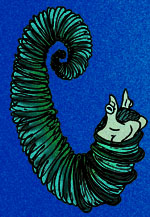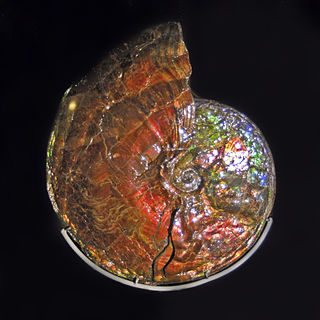Bauchioceras is an extinct genus of cephalopod belonging to the Ammonite subclass.

Ainoceras is a genus of extinct, aberrantly coiled ammonite cephalopod that live in the Pacific Ocean during the Campanian division of the Cretaceous, where Japan is today. Their shells were coiled very similarly to the related Anaklinoceras, in that, when young, the shell coiled helically, and then upon reaching adulthood, the shell then bent over the older coils. However, Ainoceras differed in this respect in that, whereas in Anaklinoceras, the youngest coil wrapped very closely around the older coils, while in Ainoceras, the youngest coil bent over the older coils in a wide loop or oxbow.
Anaklinoceras is a genus of extinct heteromorph ammonite cephalopod that lived in marine environments in what is now Western North America during the Campanian division of the Cretaceous period. Their shells were very similar to the related ammonites of the genus Ainoceras, where the young ammonite's shell coiled helically, and upon reaching adulthood, the youngest coil arched over the older coils.

Apoderoceras is an extinct genus of cephalopod belonging to the ammonite subclass.
Ankinatsytes is an extinct genus of cephalopod belonging to the Ammonite subclass. The ammonite is from the Late Cretaceous of Colombia and Venezuela.

Annuloceras is an extinct genus of ammonite cephalopod. Its fossils are found in Lower Barremian sediments from California. The genus is currently placed in the family Aegocrioceratidae.

Desmoceras is a genus of ammonites belonging to the family Desmoceratidae. These cephalopods were fast-moving nektonic carnivores. They lived in the Early Cretaceous; Albian epoch.

Calycoceras is an extinct genus of cephalopods belonging to the subclass Ammonoidea and family Acanthoceratidae that lived during the Cenomanian stage of the Late Cretaceous, 100-94 Mya. Their shells had ornate ribs.

Peroniceras is an ammonite belonging to the Ammonitida family Collignoniceratidae.

Lewesiceras is a genus of large ammonites belonging to the order Ammonitida and the family Pachydiscidae.

Hauericeras is an ammonite genus from the Late Cretaceous that lived from the Coniacian to the late Maastrichtian, from about 90 to 66 mya. Fossils have been found in Europe, Russia, South Africa, Australia, India, Iraq, and in the United States.

Eucalycoceras is an extinct genus of cephalopods belonging to the Ammonite subclass.

Phyllopachyceras is an extinct genus of ammonoid cephalopods belonging to the family Phylloceratidae. These nektonic carnivores lived in the Cretaceous, from Hauterivian to Maastrichtian to age.

Pseudothurmannia is a genus of extinct cephalopods belonging to the subclass Ammonoidea and included in the family Crioceratitidae of the ammonitid superfamily Ancylocerataceae. These fast-moving nektonic carnivores lived in the Cretaceous period, from Hauterivian age to Barremian age.

Heinzia is an extinct ammonoid cephalopod genus belonging to the family Pulchelliidae. They lived during the Cretaceous, in the Barremian age.

Placenticeras meeki is an ammonite species from the Late Cretaceous. These cephalopods were fast-moving nektonic carnivores. They mainly lived in the American Interior Basin.

Gaudryceras is an ammonite genus belonging to the family Gaudryceratidae.

Lyelliceras is a genus of ammonites belonging to the family Lyelliceratidae. These cephalopods were fast-moving nektonic carnivores. They lived in the Cretaceous period, Albian stage.

Eotetragonites is an extinct genus of ammonite.

Pictonia is an extinct ammonoid cephalopod genus belonging to the family Aulacostephanidae. These fast-moving nektonic carnivores lived during the Jurassic period, Kimmeridgian age.

















